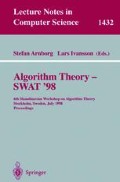Abstract
We consider the problem of preemptive non-clairvoyant scheduling on a single machine. In this model a scheduler receives a number of jobs at different times without prior knowledge of the future jobs or the required processing time of jobs that are not yet completed. We want to minimize the total response time, i.e. the sum of times each job takes from its release to completion.
One particular algorithm, Balance, always schedules the job that was least processed so far. A comparison of an on-line scheduler running Balance against the optimal off-line shows a very large competitive ratio if both algorithms use machines of the same speed. However, it has been shown if Balance is run on a v times faster machine then the competitive ratio drops to at most 1 + 1/(v−1). This result showed that speed can almost be as good as clairvoyance.
We show for v ≥ 2 the competitive ratio of Balance is 2/v. In other words, sufficiently high speed is more powerful than clairvoyance.
Preview
Unable to display preview. Download preview PDF.
References
S. Albers, Better bounds for online scheduling, STOC (1997), 130–139.
S. Irani and A. Karlin, Online Computation, in D. Hochbaum (ed.), Approximation Algorithms for NP Hard Problems, PWS Publishing, Boston MA, 1997, 521–563.
B. Kalyanasundaram and K. Pruhs Speed is as powerful as clairvoyance, FOCS (1995), 214–221.
T. Matsumoto, Competitive analysis of the round robin algorithm, International Symposium on Algorithms and Computation (1992), 71–77.
R. Motwani, S. Phillips and E. Torng, Non-clairvoyant scheduling, SODA (1993), 422–431.
C. Phillips, C. Stein, E. Torng and J. Wein, Optimal time-critical scheduling via resource augmentation, STOC (1997), 140–149.
W. Smith, Various optimizers for single-stage production, Naval Research Logistics Quarterly (1956), 59–66.
A. Tannenbaum and A. Woodhull, Operating Systems, Prentice Hall, New Jersey, 1997.
Author information
Authors and Affiliations
Editor information
Rights and permissions
Copyright information
© 1998 Springer-Verlag Berlin Heidelberg
About this paper
Cite this paper
Berman, P., Coulston, C. (1998). Speed is more powerful than clairvoyance. In: Arnborg, S., Ivansson, L. (eds) Algorithm Theory — SWAT'98. SWAT 1998. Lecture Notes in Computer Science, vol 1432. Springer, Berlin, Heidelberg. https://doi.org/10.1007/BFb0054373
Download citation
DOI: https://doi.org/10.1007/BFb0054373
Published:
Publisher Name: Springer, Berlin, Heidelberg
Print ISBN: 978-3-540-64682-2
Online ISBN: 978-3-540-69106-8
eBook Packages: Springer Book Archive

